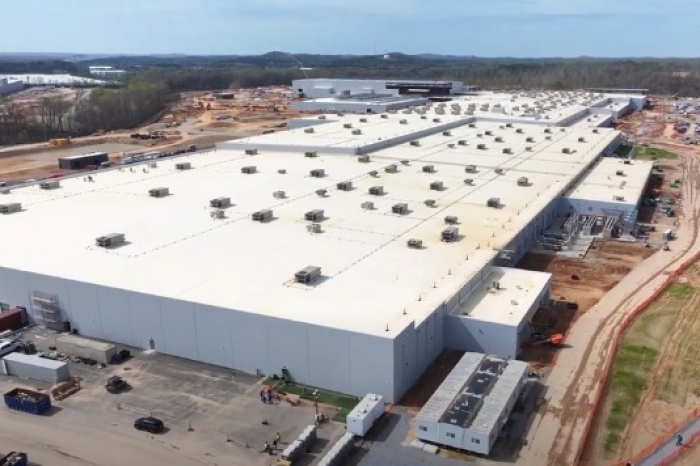Hanwha Q Cells, OCI to benefit from expanded US CHIPS Act subsidies
The US expanded the act’s coverage to the solar sector amid the influx of low-cost Chinese solar products
By Oct 31, 2024 (Gmt+09:00)
When in S. Korea, it’s a ritual: Foreigners make stops at CU, GS25, 7-Eleven


Maybe Happy Ending: A robot love story that rewrote Broadway playbook


NPS yet to schedule external manager selection; PE firms’ fundraising woes deepen


Samsung steps up AR race with advanced microdisplay for smart glasses


Seoul appeal: Korean art captivates Indonesia’s affluent connoisseurs



South Korean solar cell companies such as Hanwha Q Cells Co. and OCI Holdings Co. are set to benefit from expanded subsidies covered by the US CHIPS and Science Act.
According to industry sources on Thursday, the US Treasury plans to implement the revised CHIPS Act on Dec. 23, offering solar cell companies subsidies to cover 25% of the cost of setting up solar ingot and wafer factories in the country.
Under the revised law, Korean solar companies operating in the US market are now eligible for additional subsidies to the tune of hundreds of billions of won, or hundreds of millions of dollars, industry officials said.
This comes as the US government decided to expand the scope of the CHIPS Act, originally intended to subsidize semiconductor plants, to solar ingots and wafers.
Hanwha Q Cells, a unit of Korean chemicals-to-construction conglomerate Hanwha Group, is set to begin operations of its ingot and wafer plants, each with 3.3 GW capacity, in Cartersville, Georgia, by the middle of 2025.

Hanwha Q Cells, known as Qcells in overseas markets, is expected to receive tax credits for its investment costs once the plants start operations.
The company operates another solar cell plant in Dalton, Georgia, making it the largest silicon solar module maker in the US.
OCI Holdings, which also plans to build ingot and wafer plants in the US, is expected to gain extra tax benefits.
US ELECTION
The CHIPS Act, introduced in 2022 by the Biden administration, provides subsidies across the semiconductor value chain for facilities established in the country.
In response to the influx of low-cost Chinese solar products dominating the US energy market, the US government has decided to expand the act's subsidy coverage to the solar sector.

Given that an ingot factory requires an investment of around 220 billion to 250 billion won ($160 million-$181 million) per GW and a wafer factory requires 180 billion to 220 billion won, Hanwha Q Cells will likely spend between 1.32 trillion won and 1.55 trillion won ($957 million-$1.1 billion) in total for its ingot and wafer plants in Cartersville.
Given the costs, Hanwha Q Cells, owned by Hanwha Solutions Corp., could receive about 330 billion to 390 billion won in subsidies.
The company has already been receiving an advanced manufacturing production credit (AMPC) under the Inflation Reduction Act (IRA), which aims to support the renewable energy industry in the US.
"Barring any significant changes, we expect to qualify for the CHIPS Act subsidies,” said a Hanwha Q Cells official.
The outcome of the US presidential election could, however, be a variable.
If former President Donald Trump, the Republican candidate who opposes the use of government funds for overseas chip companies like Samsung Electronics Co. and Taiwan Semiconductor Manufacturing Co. (TSMC), wins the race, the US policy on semiconductor and energy subsidies could undergo significant changes, industry watchers said.
Write to Sang-Hoon Sung at uphoon@hankyung.com
In-Soo Nam edited this article.
-
 EnergyHanwha Q Cells builds US solar farm for power supply to Meta
EnergyHanwha Q Cells builds US solar farm for power supply to MetaMay 30, 2024 (Gmt+09:00)
1 Min read -

-
 EnergyHanwha Q Cells expects windfall gain from Chinese rivals’ woes
EnergyHanwha Q Cells expects windfall gain from Chinese rivals’ woesAug 21, 2023 (Gmt+09:00)
2 Min read -
 EnergyHanwha Q Cells to sell 7 US battery ESS projects to Spain’s Acciona Energia
EnergyHanwha Q Cells to sell 7 US battery ESS projects to Spain’s Acciona EnergiaDec 14, 2022 (Gmt+09:00)
1 Min read -
 Hanwha Q Cells secures 315MW solar power, energy storage project in Portugal
Hanwha Q Cells secures 315MW solar power, energy storage project in PortugalAug 28, 2020 (Gmt+09:00)
1 Min read


